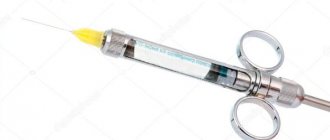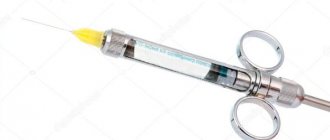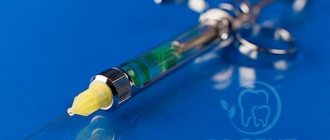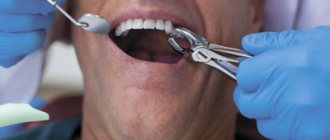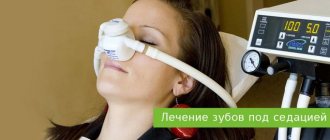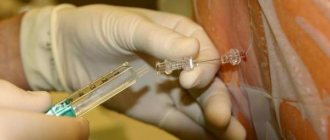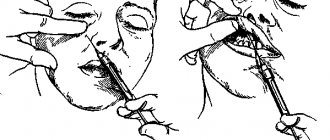What is carpule anesthesia?
Carpule anesthesia in dentistry is an injection anesthesia using a special syringe, which is called a carpule.
The use of a carpule syringe increases the safety and comfort of anesthesia.
That is, carpule anesthesia in dentistry can be of any type - the main thing is that a carpule syringe and the carpule itself with an anesthetic are used.
Carpule syringes: types and device
The instrument consists of a body, a plunger that moves up and down, and a needle changer. There is a small hole on the side of the device into which a capsule with anesthetic is inserted.
There are types of devices that differ according to the following criteria:
- Frequency of use: disposable and reusable syringe.
- Material of manufacture: plastic, metal.
- Possibility of placement in the dentist's hand. Ease of holding is one of the important qualities of the instrument, which determines the comfort and speed of procedures. In medical equipment stores you can find syringes with rings and straight handles. The number of rings can vary from one (designed for the thumb) to three (supporting the thumb, index and middle fingers). Ring-shaped clamps are able to provide a more comfortable and immovable fastening of the device in the hand, which is why they are more in demand.
- Size of rings for fixation. It is important here that the dentist can choose the size that is more comfortable for him, since the convenience of holding the syringe in his hand and the effectiveness of the procedure depend on this.
Reusable
The carpule syringe in dentistry is found in the form of a reusable instrument made from the following materials:
- titanium;
- brass;
- stainless steel;
- high quality plastic.
Features of the use of tools are:
- There is a need for sterilization.
- No guarantee of quality processing.
- There is a small risk of infection (according to statistics, there is 1 infection per 90 procedures).
- There is a need to disassemble, fold, clean and disinfect the syringe.
- Increased time spent on tool processing and cleaning.
- There is a small chance of a negative aspiration test.
- No guarantee of safety, reliability, or risk of injury.
- More expensive anesthesia.
- Only foreign-made syringes are available for sale.
Disposable
Today, plastic disposable instruments are available for sale.
Features of product use include:
- No need to sterilize instruments.
- There is 100% protection against cross-infection between the dentist and the patient.
- There is no unnecessary manipulation of sterilization or disassembly, which reduces procedure time.
- The products have a lower cost of anesthesia.
- The procedure meets current standards in dentistry.
- Obtain an aspiration sample during each local anesthesia procedure.
- Safety and reliability of the method.
Equipment
Essentially, a carpule syringe is a metal dental anesthesia syringe that can be used many times and is sterilized in the same way as other dental instruments. A carpule with an anesthetic is inserted into the carpule syringe - a special glass cartridge, factory-made.
Currently, the Trilogy Medical and Dental Center uses carpule syringes for injection anesthesia - they are much more convenient and more sophisticated than conventional disposable syringes.
Advantages of carpule pain relief
The most important advantages of carpulal anesthesia can be considered:
- The exact amount of the drug in 1 ampoule is exactly 1.7 ml. Thanks to this, the doctor can count the carpules and know exactly the dosage of the administered drug.
- Complete sterility. Carpules are manufactured and sealed in a warehouse under completely sterile conditions. This way you can be sure of the quality of the injected drug.
- Less pain from the injection itself. Patients feel less pain when punctured because the needle of a carpule syringe is much thinner and more flexible than that of a regular syringe.
- It is more convenient for the doctor to control the process. The dental anesthesia carpule syringe fits very comfortably in the hand thanks to special handles and stops. Also due to the greater flexibility of the needle, it can be bent in almost any direction without fear of it breaking off.
- Elimination of errors. When using Carpules, the possibility that the doctor will administer the wrong drug or in the wrong quantity or concentration is completely eliminated. After all, with carpule anesthesia, the doctor always knows exactly what he is injecting - the name of the drug, its concentration and quantity is written on each carpule.
Carpule needles
The carpule needle includes a metal tip and a plastic connecting cone (coupling). Providing easy and painless administration of the medicinal solution, it has a number of important characteristics:
- The presence of two ends, making the entire process absolutely safe. The long edge of such a needle, designed to penetrate the tooth tissue, ends with a cut. But the shorter one is used to open and seal sealed carpules;
- The presence of a red mark indicates exactly how to hold the syringe;
- Unique design – improves the quality of medical services, reduces the patient’s time in the dental chair;
- Thinness, strength, sharpness and increased flexibility - eliminate the development of various infections, eliminate discomfort, and allow you to reach even hard-to-reach areas of the oral cavity.
Carpule needles come in short (from 10 to 25.5 mm) and long (from 28.9 to 41.5 mm). Many companies produce standard length models - 12, 16, 25, 35, 38 mm. It is better to buy them in packs of 100 pieces, making sure that the label indicates the name and address of the manufacturer, production date, expiration date, as well as the type, length and number (outer diameter) of the needle.
Example! Sopira, USA, 01.2019, 0.30 x 21 mm.
Experts recommend using needles from trusted companies that guarantee high quality products. They must be in plastic packages, the sterility of which is ensured by paper seals or control cuts. Products of dubious quality do not have good cross-country ability. This can lead to needle fracture, periosteal injury, and severe pain.
Disadvantages of carpule anesthesia
Despite the minor disadvantages described below, carpule anesthesia in dentistry is currently considered the safest and most modern option for injecting an anesthetic.
- Higher price of equipment.
Carpule syringes are more expensive per unit than disposable syringes. This is due to the fact that syringes with carpules for anesthesia in dentistry are quite complex in design, plus really high-quality ones will cost more than simpler options.
- It is impossible to change the concentration of anesthetic inside the cartridge - the cartridge is completely sealed and it is not possible to add anything inside.
How to install the carpool?
In dentistry, a carpule syringe is used in combination with cartridges (sealed containers with an anesthetic substance). To install a capsule in a syringe, you need to know the distinctive characteristics of its structure.
Based on the method of fixing the cartridge, products can be divided into 3 types:
- Spring. With this design, the capsule can be placed in the syringe only after tensioning a special spring, which clamps it in the desired position.
- Block-shaped. Such a lock implies the need for retraction at an angle at the back of the syringe. Then you should put the carpule in place and return the movable part of the device to its original position.
- Bayonet. The fixation method is based on axial movement, turning the capsule and syringe touching each other when installed in the intended location.
The spring and block fastening is quite durable during operation. The bayonet installation method is less thorough and durable with frequent use.
Conditions that local anesthetics must adhere to
In general, local anesthetics should:
- Do not cause allergies
- Have minimal toxicity to the body
- Have few side effects
- Easy to dissolve and excrete
In addition to this, anesthetic agents are required to:
- The effect is strong enough to completely anesthetize the tooth and surrounding tissues.
- Rapid numbness - no more than 5 minutes after the injection
- The numbness should last at least an hour - so that it is enough for the entire procedure, including the very last manipulations
- Anesthesia should take place no more than 2-3 hours later.
- Long-term stability of the drug itself – at least 2–3 years
Injector contents
Each doctor studies the composition of drugs used for anesthesia. The packaging of the medicine indicates the percentage content of the elements included in the drug. Each element plays an important role in the drug.
Main components of the injector:
- Anesthetic. The main part of the drug that reduces sensitivity. Most often these are Lidocaine, Prilocaine, Articaine.
- Vasoconstrictor – vasoconstrictor (adrenaline, mezaton). Necessary to enhance the effect of the anesthetic. But it is contraindicated for people with heart problems, diabetes, and the elderly.
- Antioxidants (sulfites and bisulfites). They protect the vasoconstrictor from destruction when exposed to oxygen. Due to the sulfur content they can cause allergies and intolerances. Not used for patients suffering from diseases of the respiratory system.
- Preservatives. Responsible for the safety of the drug until use.
- EDTA is a metal-binding element.
- Parabens. Maintain the sterility of the drug.
Before the anesthesia procedure, the doctor must make sure that the patient does not have a negative reaction to the elements included in the drug, otherwise there will be serious consequences for the person’s health and life.
Storage rules and periods
In order not to violate the shelf life of the drug, it is necessary to strictly follow several rules for storing capsules:
- Store in a dark place.
- Temperature range – 23-25 degrees.
- Inaccessibility to children and animals.
It is strictly prohibited to use capsules stored incorrectly.
The unsuitability of the drug can be determined by its appearance. Main features:
- Violation of the integrity of the packaging.
- Presence of sediment.
- Color change.
- The appearance of bubbles.
- Rust on the ampoule.
Requirements for drugs
Each product used for pain relief must meet the basic requirements of the dentist.
The first priority, of course, is patient safety. The medicine should not cause allergies, contain toxins, or have serious side effects.
Secondly, the doctor must be sure that the duration of exposure to the drug is sufficient to carry out the intended therapeutic actions.
Popular means
For carpule anesthesia in dentistry, drugs from French manufacturers are more often used, which meet quality characteristics and are affordable.
The most common:
- Ultracaine. It acts within a minimum period of time (1-2 minutes) after administration.
- Ubistezin. The action lasts 25-30 minutes. Suitable for children and pregnant women.
- Scandonest. Includes a large amount of adrenaline. Provides minimal bleeding.
- Septanest. Works for 15-20 minutes. More often used for people with health problems.
Reasons for the lack of pain relief
It often happens that after the administration of anesthesia, sensitivity in the area of the upcoming treatment is retained completely or partially. One of the reasons is poor quality of the drug. But there are other reasons:
- Fear that blocks reflexes.
- The production of adrenaline, which neutralizes the effect of the drug.
- Alcohol addiction.
- Accustoming the body to the drug.
Treatment technologies are developing, new developments are being created to improve the quality of dental services.
Carpule anesthesia is used in every dental clinic. Anesthesia helps make the treatment more comfortable and also reduces the patient's fear of the upcoming procedure.
The best anesthetic – does it exist?
As we said above, almost all modern anesthetics are made on the basis of articaine, so there is not such a fundamental difference between them. Most patients are anesthetized with Ultracaine or Ubestezin.
But we must also take into account that, of course, it is important what is injected, but it is also important how it is done - a lot depends on the doctor and the technique of performing anesthesia.
Indications, contraindications and consequences of carpules anesthesia depend more on the type of anesthesia - infiltration or conduction, than specifically on the carpules. But, as we noted earlier, with carpule anesthesia there is no risk of administering the wrong drug and there is virtually no risk of the needle breaking off.

